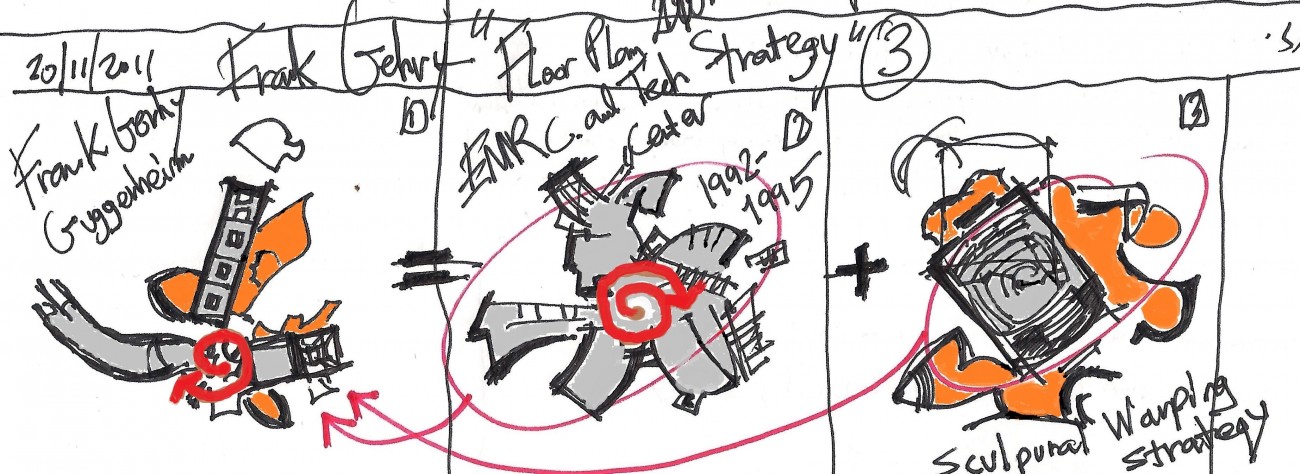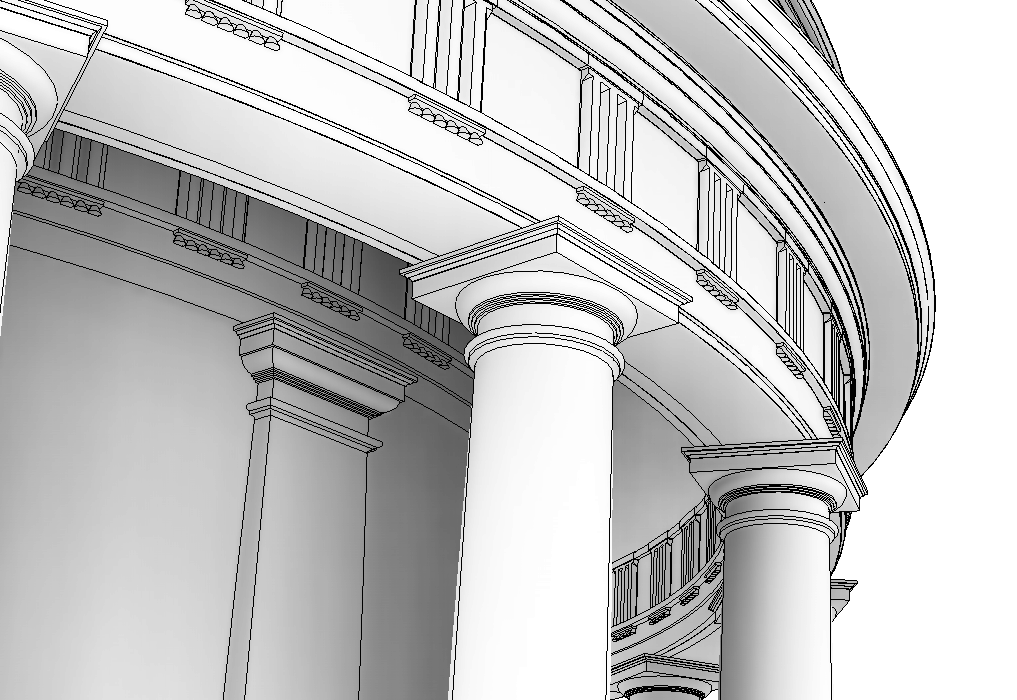
Featuring the hand sketches of Frank Gehry provides an inside look into Mr. Gehry’s architecture. “I know I draw without taking my pen off the page. I just keep going, and that my drawings I think of them as scribbles. I don’t think they mean anything to anybody except to me, and then at the end of the day, the end of the project they wheel out these little drawings and they’re damn close to what the finished building is and it’s the drawing.” Frank Gehry, FAIA. Because Mr. Gehry’s sketches are original and unique, we thought it fitting to launch our CFAeX Autodesk AutoCAD, Revit, and BIM Certification Exams home page is showcasing his work. The CFAeX.com website has compiled a slideshow for you. View the slide show.


Author Paul Aubin’s latest book: Renaissance Revit: Creating Classical Architecture with Modern Software was published this week. Paul Aubin is a well-respected author of dozens of books on Building Information Modeling using Revit and other Autodesk software. His latest book tackles a subject never before approached in the world of Revit training manuals. In this exquisite hands-on guide, Paul Aubin walks you through two of his passions; Revit and Classical Architecture for the price of one. Take a virtual tour through the history of architecture in a way like no other. Paul Aubin’s book is a tutorial of epic proportions that does not just talk about creating Doric, Ionic and Corinthian columns; it walks through the process step-by-step! Following along with Paul as your guide, at the end of this book you will have built four of the five classical orders.
The steps are easy to follow for both veteran Revit users and novices alike. You’ll begin by learning the basics required to successfully create robust and fully parametric Revit family content. Next you’ll apply what you learned by building a simple schematic version of a Tuscan column. This will become a coarse detail version in later lessons and becomes what Paul refers to as the “seed” for future families. Each chapter is packed with useful tips that apply not just to creating classical architectural forms, but any Revit family. In fact, that is what makes this book so powerful. It is cloaked in classical architecture, but at its core it is the ultimate family editor’s guide to Revit content creation. The classical families just make for a really fun way to learn about Revit content creation. And of course, if your work does involve the classical orders, then you come away with some very useful examples at the end of the book.
Each chapter builds on the previous as you learn to control complex forms and shapes in a fully flexible and parametric way. Take these forms and create reusable components such as profiles and family seeds. As the chapters unfold, you take a journey through history as the orders become progressively more complex: Tuscan to Doric, Doric to Ionic and culminating in a fully parametric Corinthian capital.
We highly recommend Author Paul Aubin’s new book. It is of particular interest to anyone interested in Revit family creation. The book is available in two editions: black and white and a stunning full color edition. The full color one comes at higher cost, but is easy to justify given how much better the book’s numerous illustrations pop off the page in full color. So don’t hesitate, jump over to Paul Aubin Website today to learn more and order your copy!
Paul has been active in the architectural community for nearly 25 years. Paul Aubin is a former Consulting For Architects, Inc. (CFA) employee living in Chicago. Paul Aubin and had the pleasure of working together from March 1996 – March 2004. As a CFA employee Paul Aubin was instrumental in developing and teaching Autodesk© AutoCAD© and Revit©, BIM to 100’s of architects and designers at CFA’s Autodesk ATC©, and developing CFA’s CAD test – known as CFAeX Knowledge Assessment Tools
Online job ads for architects up 20% over year
 Online job advertisements for architects rose 20 percent during the last 90 days compared to the same time period in 2012, according to Wanted Analytics, a firm that tracks online job ads. There were a total of more than 16,000 architect jobs advertised in the past 90 days.
Online job advertisements for architects rose 20 percent during the last 90 days compared to the same time period in 2012, according to Wanted Analytics, a firm that tracks online job ads. There were a total of more than 16,000 architect jobs advertised in the past 90 days.
New York, Los Angeles, Washington D.C., San Francisco and Houston topped the list of metropolitan areas with the most job ads for architects.
“Autodesk AutoCAD” was the most commonly required skill in architect jobs. In the past 90 days, 5,500 jobs required CAD skills, representing about 35 percent of all hiring demand.
The most commonly required skills in architecture jobs include:
Autodesk REVIT Architecture
Oral and written communication skills
Detail oriented
Self-starting/self-motivated
Project management
Organizational skills
Bentley MicroStation
Microsoft Office
Adobe Photoshop
Watch a new CCTV America video from the AIA.org website that highlights 7 consecutive months of gains in the industry
Temporary hiring takes center stage
U.S. temporary employment jumped by 20,300 jobs in March, compared with the previous month, and the year-over-year growth rate ticked up, according to seasonally adjusted numbers released today by the U.S. Bureau of Labor Statistics. In addition, the number of temp jobs added in February was revised upward by 22,000 jobs.
Year-over-year growth in temp jobs had been decelerating since November. However, the number of temp jobs rose by 6.4 percent year over year in March, up from the 5.3 percent increase in February.
Further, the U.S. temp penetration rate rose to 1.94 percent in March from 1.93 percent in February.
However, the U.S. added fewer jobs overall in March than February. Total non-farm employment rose by 88,000 jobs in March compared with an increase of 218,000 in February – Sending a clear signal that firms are exercising caution, temporary hires outpaced permanent hires for the same period.
The U.S. unemployment rate still fell to 7.6 percent in March from 7.7 percent in February. The college-level unemployment rate, which can serve as a proxy for professional employment, was unchanged from February at 3.8 percent.
In other industries, construction added 18,000 jobs in March. The BLS reported construction has added 169,000 jobs since September.
Click on the chart below to enlarge.

Click on the chart below to enlarge.

This post is a composite of articles from Staffing Industry Analysts and AIA.org websites
aia, architect, architects, architecture, architecture jobs, construction, David McFadden, Hiring trends, recession, starting a business, Uncategorized, unemployed architects
|
architecture, Architecture billings index, AutoCAD, Autodesk, bentley microstation, BLS, business, construction industry, construction spending, design, Houston, jobs, Los Angeles, New York, recession, Revit Architecture, San Francisco, unemployed architects, Washington D.C.
|
A company known for niche design programs ventures into the mass market. But why?
Autodesk does well-over $2 billion in annual revenues, but unless you’re a designer, you probably don’t know the company: They produce sophisticated programs, often costing thousands of dollars, which are necessary tools in design professions ranging from architecture to digital animation.
So it’s a bit of surprise that lately, they’ve been fooling around with iPad and web apps geared towards a mass audience. Some of their offerings include Sketchbook, an iPhone/iPad app that’s been downloaded almost 2 million times; and Homestyler, a web app that lets you create and decorate a 3-D model of your home. Yet despite those successes, those products seem piddling against yearly profits of over $200 million.
FastCompany.com recently spoke with Amar Hanspal, Autodesk’s SVP of emerging business, about what those ventures portend for the company’s future.
Full article vis FastCompany
I have said numerous times lately that the lessons of this prolonged recession and necessity to achieve efficiency’s to survive will be a game changer for BIM acceptance in AEC firms. Everyday I see evidence supporting that. Here is a post from a firm in Salem, MA that agrees that BIM is key in moving forward and competing:

Photo-realistic BIM Rendering of the Salem State College, Weir-Stanley Building Music Rehearsal Space
If you haven’t done it by now, you better get to it! Or fall so far behind you may never be able to catch up. Bite the BIM bullet. It’s the future of the building industry and the future is now or just around the corner. Our firm swallowed the BIM pill way back in 2003; a year after Revit was first introduced to the market by Autodesk. What we saw then was what other industries have been doing for years: virtually prototyping and testing designs prior to fabrication. Economics and compute power had the practice relegated to big business and complex industries, but now the industrial evolution has finally availed these tools to the AEC Industry that allow us to rise up and shed our Neanderthal trappings. Those who will not adapt and wait, or dismiss it as a passing fad, will surrender to Natural Selection ending up in their own version of the La Brea Tar Pits. What BIM allows us to do is create buildings in the same way that we think about them; as visualized complete projects. We don’t think in plans, elevations, sections and details. These methods deconstruct the total visualized idea into two dimensional components simply to communicate complexities of the idea to someone else or to allow us to coordinate others’ work into our complex idea.
Full article via Winter Street ArchitectsBlog















